Increasing cow numbers and the addition of a new out-farm, led father and son duo, Michael and Tom O’Dwyer, to consider upgrading the farm loader. Currently milking 140 cows, Tom was working in the agricultural industry after completing a four-year degree in agriculture, but has recently returned to the farm on a full-time basis. After recently upping the land area being farmed by Tom and his father, they plan on increasing cow numbers by 40 to 50.
Based just outside Kilfinane in Co Limerick, the family has been using a trusty JCB 2CX for typical loader duties for the previous 12 years. Before that, it was a Ford 7740 with a front-end loader.
When it came to updating the loader, the O’Dwyers carefully considered all their options. Tom has been working with an agricultural contractor during the summers for many years, and has a keen eye for machinery.
“While in our local John Deere dealer one day, we priced a 6120M with a front-end loader. We have a John Deere 6430 that we could have fitted a front-end loader to also, but based on previous experience, we feel that a loader is too hard on the tractor’s front-axle, especially when using it for a lot of road work. We looked at both new and used loaders. We looked at side-boom JCBs and Manitous, and centre-pivot Claas, JCB and New Holland machines. We have some low sheds and tight passageways, so we decided to go down the centre-pivot route. A new New Holland loader was roughly coming in at the same price as a used JCB TM 310. Where possible, we like to buy new, as you know exactly what you have and you’re not buying someone else’s trouble, so we went with the New Holland,” explained Tom.

The duo is very impressed with the control layout, which sees all the controls positioned on the operator’s right-hand side.

One point noted by Michael, was how easy it was to access the loader through the wide opening glass door.
Engine and transmission
The W80C is the flagship model in New Holland’s four-model, four-wheel drive, articulated steering range. The series features power outputs from 58hp up to 75hp, and operating capacities of 1.9t-2.5t, to a height of 3.1m to 3.4m.
The entire four-model C-series of compact wheel loaders are powered by the same four-cylinder, 3.4 litre Common Rail FPT Industrial engine. On the larger W70C and W80C models, this engine churns out 75hp and up to 316Nm of torque.
The FPT motor is matched up to a two-range hydrostatic transmission, which simply allows the operator to press the accelerator and go. Maximum road speed is 33km/h, when the optional high travel speed is specified. Tom noted that the loader will hit up to 36km-37km/h. With the inching and brake pedal, more power can be diverted to the loader’s hydraulics without disconnecting the drive, while maintaining a constant engine rpm. A creep speed option is available, whereby the travel speed can be set and adjusted in the 1-5km/h range, useful for running a hydraulic attachment, such as a road sweeper.
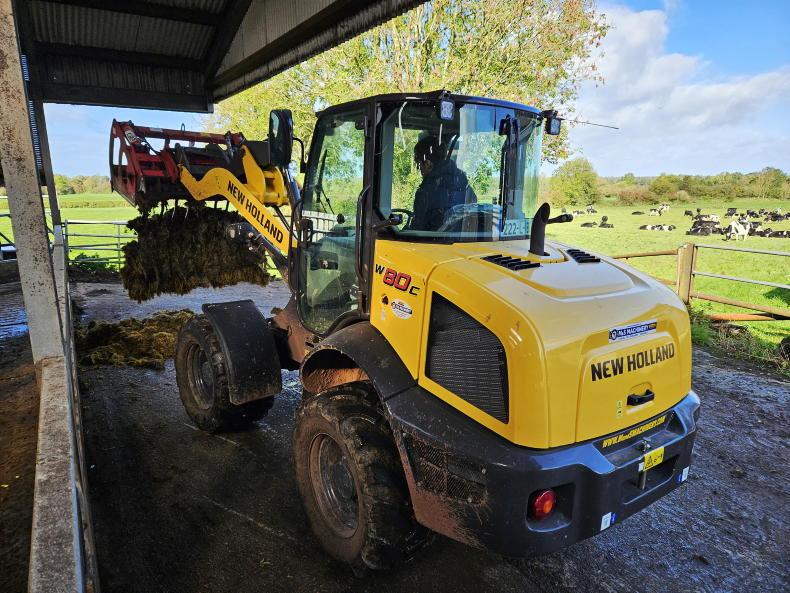
The W80C is 1.86m (6ft 1in) wide and has an overall cab height of 2.68m (8ft 9.5in).
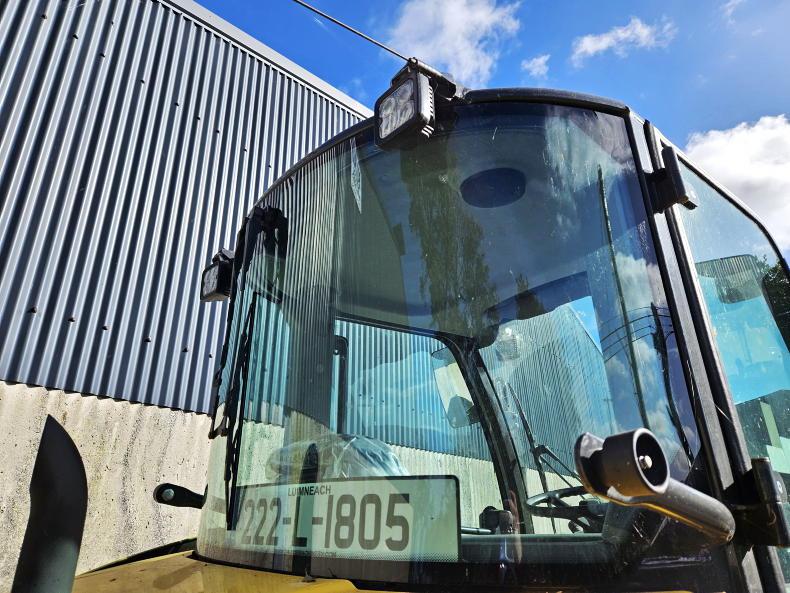
Both agree that the slim pillars and curved rear windscreen offer very good visibility.
Hydraulics and features
The two larger models come with a choice of the standard 85l/min hydraulic pump or the high flow pump option, which is capable of producing 130l/min. On all models, the pump powers both the hydraulics and the steering, and for safety, there is a priority valve to favour the steering demand.
The range features a steering angle of 40° to each side and fully hydraulic centre pivot steering, where the front and rear wheels follow the same track. The rear-axle oscillates to a total angle of 20 degrees. The manufacturer’s soft ride system, known as ‘glide-ride’, self-activates when needed over 5.5km/h.
The W80C features three differential configurations, including limited slip front and rear, front and rear open differential or open with 100% lock on front and rear differentials. The O’Dwyers opted for wider 550/45 R22.5 tyres.
The range comes with two choices of linkage, either the Z-bar linkage or the TC linkage. This loader features the Z-bar, which is the most versatile linkage type. It features two lifting cylinders and a higher dump height, designed for agricultural applications. With an operating weight of 5,559kg, the loader has a tipping load of 3,100kg, and has a maximum lifting height to the hinge pin of 3.29m (10ft 9.5in).

The entire four model C-series is powered by the same four-cylinder, 3.4l FPT engine.

Tom O’Dwyer
Cab
The manufacturer’s C-series of compact wheel loaders features a newly designed cab, which has been lowered to improve accessibility to low buildings. The W80C is 1.86m (6ft 1in) wide and has an overall cab height of 2.68m (8ft 9.5in).
One point noted by Michael, was how easy it is to access the loader through the wide-opening glass door. Both father and son agree that the central high driving position, coupled with the slim pillars and curved rear windscreen, offer very good visibility.
The duo is very impressed with the control layout, which sees all the controls positioned on the operator’s right-hand side. This includes the electro hydraulic multi-function joystick, with forward/reverse, proportional auxiliary control, flow memory button and a float function.
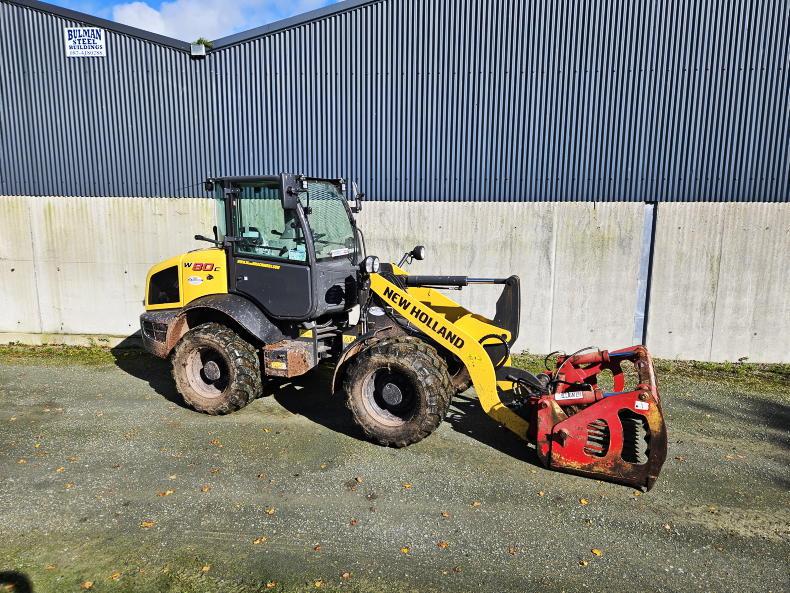
The rear axle oscillates to a total angle of 20 degrees.
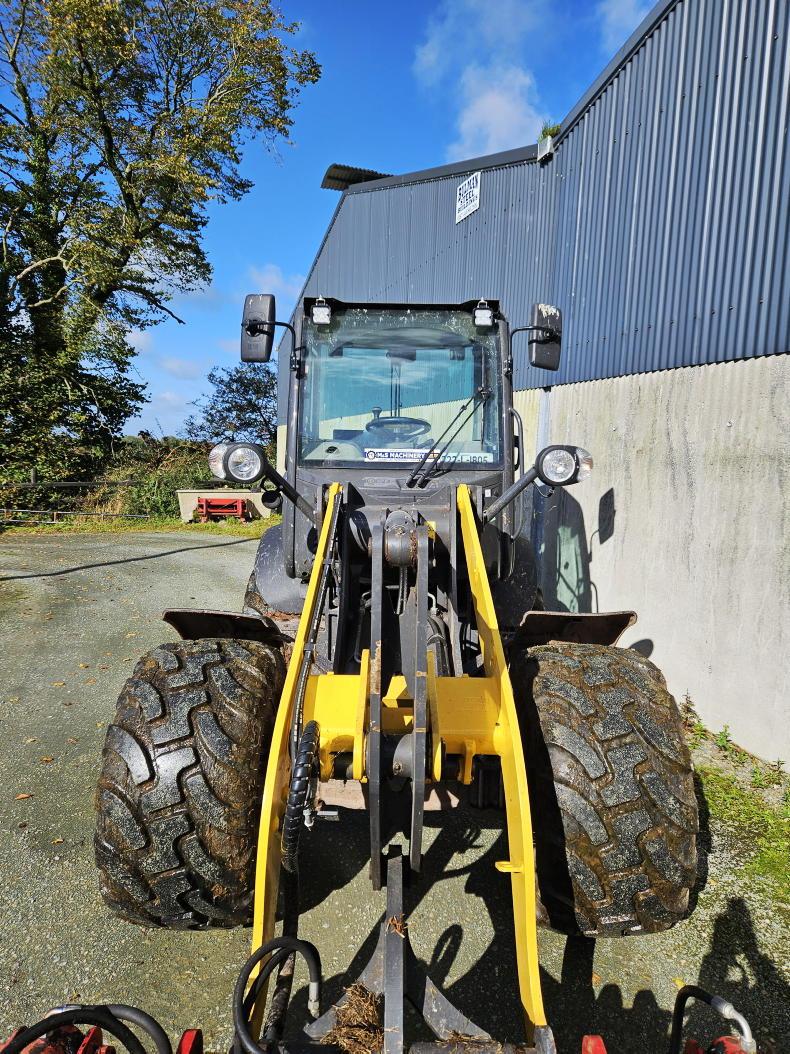
The manufacturer’s soft ride system, known as ‘Glide-Ride’, self-activates when needed over 5.5km/h.
With just over a year’s work put through the loader, the father and son team are very happy with their investment.
“The only optional extra we went for was fitting wider tyres. This was definitely the right decision; it adds to the machine’s stability and increases its footprint on the land. The only negatives we have are that the hinges on the door seem to be a bit on the weaker side. I think it could also do with a little more weight on the rear. Other than that, we have never found the loader wanting more power. As it was our first hydrostatic loader, it took a little bit of getting used to, but we would never go back to a powershift loader again. The cab is easy to get in and out of, and offers very good visibility. The cab is fairly snug, you definitely wouldn’t be fitting a second person in it anyway. But in fairness, the controls are very well laid out. Overall, we’re very happy with our decision to have gone with the New Holland machine”, concluded Tom.


The electro hydraulic multi-function joystick controls forward/reverse, proportional auxiliary control, flow memory button and a float function.
Likes
Easy to get in and out of the cab.Controls are well laid out.Quick hydraulics.Smooth ride system.Dislikes
Would like more weight on the rear.Door hinges seem a bit weak.
With an operating weight of 5,559kg, the loader has a tipping load of 3,100kg, and has a maximum lifting height to the hinge pin of 3.29m (10ft 9.5in).
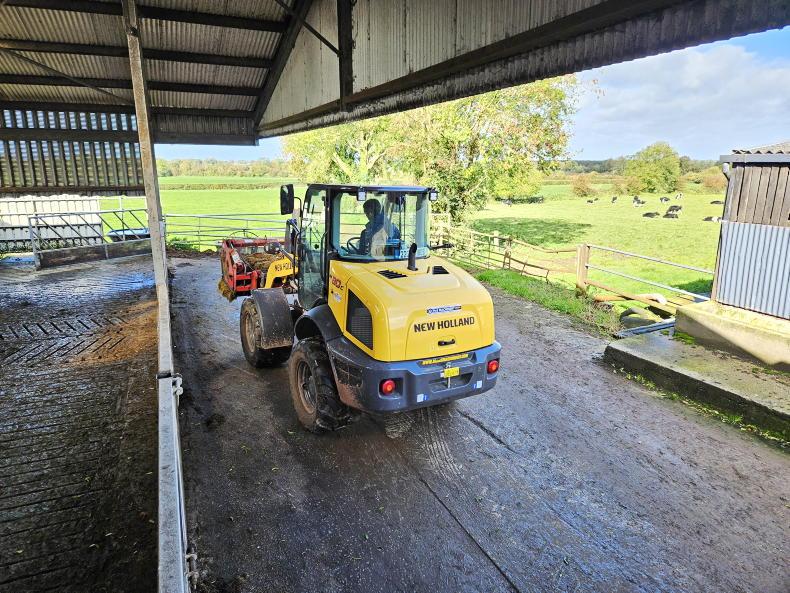
The Z-bar linkage features two lifting cylinders.
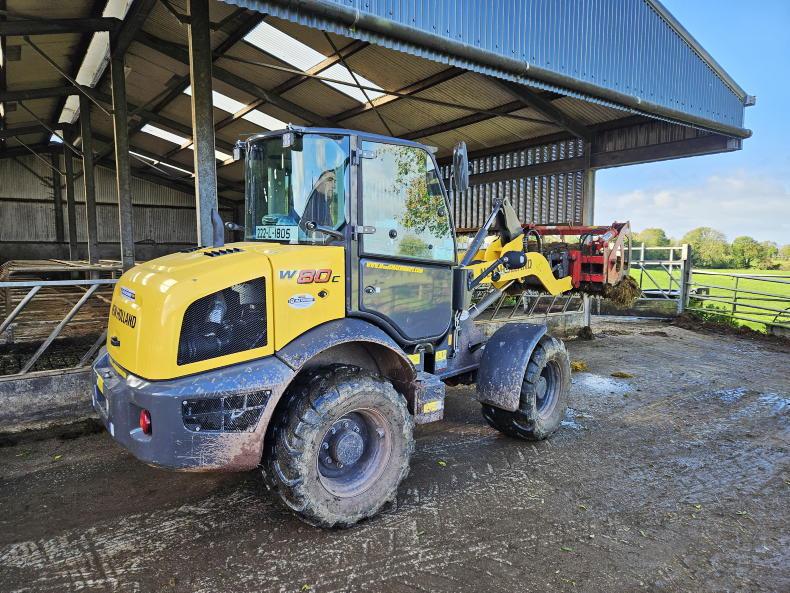
"Overall, we’re very happy with our decision to have gone with the New Holland machine”, concluded Tom.
The spec
Engine: 3.4l four-cylinder FPT.Horsepower: 75hp.Transmission: 33km/h two speed hydrostatic.Hydraulics: 85l/min (130l/min optional).Max lifting height (hinge pin): 3.29mFuel tank: 87l.Tyres: 550/45 R22.5 (optional extra).Ground clearance: 490mm.Tipping load (straight): 3,100kg.Operating weight: 5,559kg. Cab height: 2,680mm.Service interval: 500 hours. Starting price: €80,000 plus VAT.
"As it was our first hydrostatic loader, it took a little bit of getting used to, but we would never go back to a powershift loader again".
Increasing cow numbers and the addition of a new out-farm, led father and son duo, Michael and Tom O’Dwyer, to consider upgrading the farm loader. Currently milking 140 cows, Tom was working in the agricultural industry after completing a four-year degree in agriculture, but has recently returned to the farm on a full-time basis. After recently upping the land area being farmed by Tom and his father, they plan on increasing cow numbers by 40 to 50.
Based just outside Kilfinane in Co Limerick, the family has been using a trusty JCB 2CX for typical loader duties for the previous 12 years. Before that, it was a Ford 7740 with a front-end loader.
When it came to updating the loader, the O’Dwyers carefully considered all their options. Tom has been working with an agricultural contractor during the summers for many years, and has a keen eye for machinery.
“While in our local John Deere dealer one day, we priced a 6120M with a front-end loader. We have a John Deere 6430 that we could have fitted a front-end loader to also, but based on previous experience, we feel that a loader is too hard on the tractor’s front-axle, especially when using it for a lot of road work. We looked at both new and used loaders. We looked at side-boom JCBs and Manitous, and centre-pivot Claas, JCB and New Holland machines. We have some low sheds and tight passageways, so we decided to go down the centre-pivot route. A new New Holland loader was roughly coming in at the same price as a used JCB TM 310. Where possible, we like to buy new, as you know exactly what you have and you’re not buying someone else’s trouble, so we went with the New Holland,” explained Tom.

The duo is very impressed with the control layout, which sees all the controls positioned on the operator’s right-hand side.

One point noted by Michael, was how easy it was to access the loader through the wide opening glass door.
Engine and transmission
The W80C is the flagship model in New Holland’s four-model, four-wheel drive, articulated steering range. The series features power outputs from 58hp up to 75hp, and operating capacities of 1.9t-2.5t, to a height of 3.1m to 3.4m.
The entire four-model C-series of compact wheel loaders are powered by the same four-cylinder, 3.4 litre Common Rail FPT Industrial engine. On the larger W70C and W80C models, this engine churns out 75hp and up to 316Nm of torque.
The FPT motor is matched up to a two-range hydrostatic transmission, which simply allows the operator to press the accelerator and go. Maximum road speed is 33km/h, when the optional high travel speed is specified. Tom noted that the loader will hit up to 36km-37km/h. With the inching and brake pedal, more power can be diverted to the loader’s hydraulics without disconnecting the drive, while maintaining a constant engine rpm. A creep speed option is available, whereby the travel speed can be set and adjusted in the 1-5km/h range, useful for running a hydraulic attachment, such as a road sweeper.

The W80C is 1.86m (6ft 1in) wide and has an overall cab height of 2.68m (8ft 9.5in).

Both agree that the slim pillars and curved rear windscreen offer very good visibility.
Hydraulics and features
The two larger models come with a choice of the standard 85l/min hydraulic pump or the high flow pump option, which is capable of producing 130l/min. On all models, the pump powers both the hydraulics and the steering, and for safety, there is a priority valve to favour the steering demand.
The range features a steering angle of 40° to each side and fully hydraulic centre pivot steering, where the front and rear wheels follow the same track. The rear-axle oscillates to a total angle of 20 degrees. The manufacturer’s soft ride system, known as ‘glide-ride’, self-activates when needed over 5.5km/h.
The W80C features three differential configurations, including limited slip front and rear, front and rear open differential or open with 100% lock on front and rear differentials. The O’Dwyers opted for wider 550/45 R22.5 tyres.
The range comes with two choices of linkage, either the Z-bar linkage or the TC linkage. This loader features the Z-bar, which is the most versatile linkage type. It features two lifting cylinders and a higher dump height, designed for agricultural applications. With an operating weight of 5,559kg, the loader has a tipping load of 3,100kg, and has a maximum lifting height to the hinge pin of 3.29m (10ft 9.5in).

The entire four model C-series is powered by the same four-cylinder, 3.4l FPT engine.

Tom O’Dwyer
Cab
The manufacturer’s C-series of compact wheel loaders features a newly designed cab, which has been lowered to improve accessibility to low buildings. The W80C is 1.86m (6ft 1in) wide and has an overall cab height of 2.68m (8ft 9.5in).
One point noted by Michael, was how easy it is to access the loader through the wide-opening glass door. Both father and son agree that the central high driving position, coupled with the slim pillars and curved rear windscreen, offer very good visibility.
The duo is very impressed with the control layout, which sees all the controls positioned on the operator’s right-hand side. This includes the electro hydraulic multi-function joystick, with forward/reverse, proportional auxiliary control, flow memory button and a float function.

The rear axle oscillates to a total angle of 20 degrees.

The manufacturer’s soft ride system, known as ‘Glide-Ride’, self-activates when needed over 5.5km/h.
With just over a year’s work put through the loader, the father and son team are very happy with their investment.
“The only optional extra we went for was fitting wider tyres. This was definitely the right decision; it adds to the machine’s stability and increases its footprint on the land. The only negatives we have are that the hinges on the door seem to be a bit on the weaker side. I think it could also do with a little more weight on the rear. Other than that, we have never found the loader wanting more power. As it was our first hydrostatic loader, it took a little bit of getting used to, but we would never go back to a powershift loader again. The cab is easy to get in and out of, and offers very good visibility. The cab is fairly snug, you definitely wouldn’t be fitting a second person in it anyway. But in fairness, the controls are very well laid out. Overall, we’re very happy with our decision to have gone with the New Holland machine”, concluded Tom.


The electro hydraulic multi-function joystick controls forward/reverse, proportional auxiliary control, flow memory button and a float function.
Likes
Easy to get in and out of the cab.Controls are well laid out.Quick hydraulics.Smooth ride system.Dislikes
Would like more weight on the rear.Door hinges seem a bit weak.
With an operating weight of 5,559kg, the loader has a tipping load of 3,100kg, and has a maximum lifting height to the hinge pin of 3.29m (10ft 9.5in).

The Z-bar linkage features two lifting cylinders.

"Overall, we’re very happy with our decision to have gone with the New Holland machine”, concluded Tom.
The spec
Engine: 3.4l four-cylinder FPT.Horsepower: 75hp.Transmission: 33km/h two speed hydrostatic.Hydraulics: 85l/min (130l/min optional).Max lifting height (hinge pin): 3.29mFuel tank: 87l.Tyres: 550/45 R22.5 (optional extra).Ground clearance: 490mm.Tipping load (straight): 3,100kg.Operating weight: 5,559kg. Cab height: 2,680mm.Service interval: 500 hours. Starting price: €80,000 plus VAT.
"As it was our first hydrostatic loader, it took a little bit of getting used to, but we would never go back to a powershift loader again".



















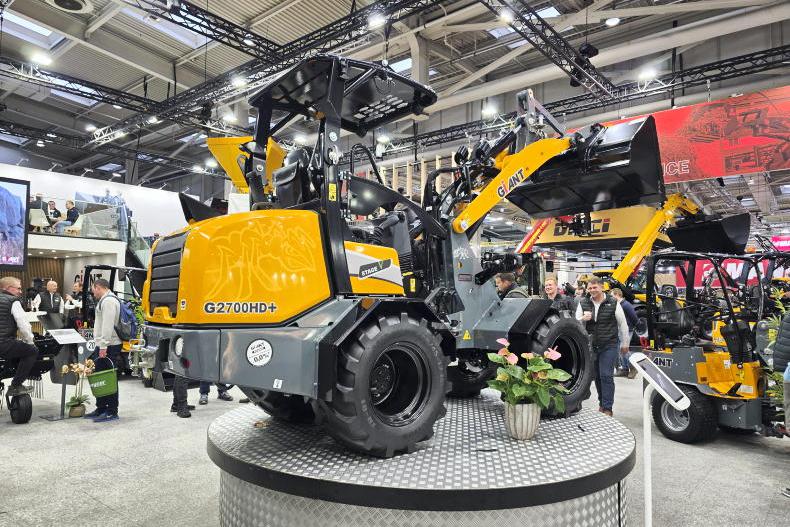



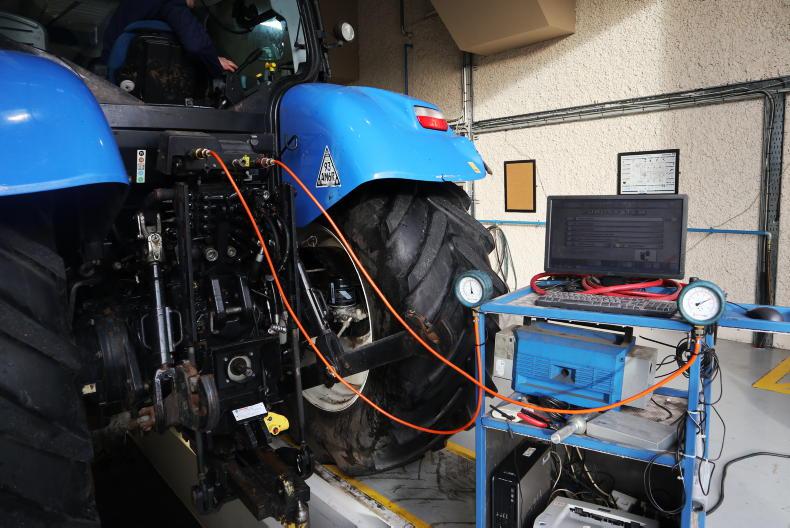
SHARING OPTIONS